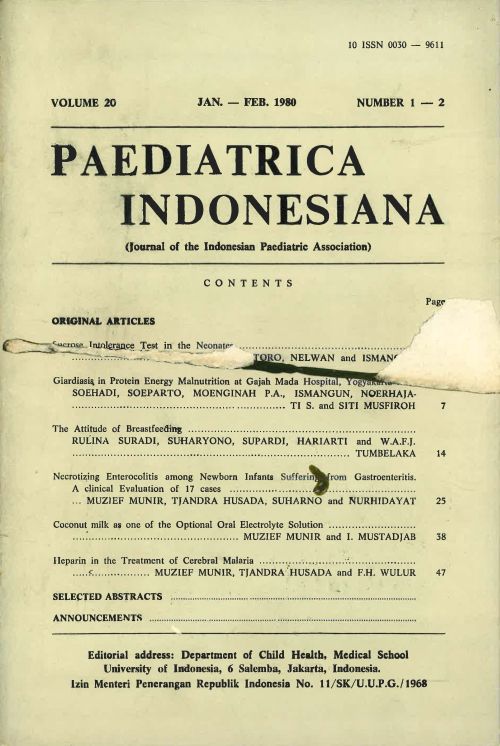Heparin in the Treatment of Cerebral Malaria
DOI:
https://doi.org/10.14238/pi20.1-2.1980.47-50Keywords:
heparin, cerebral malaria, thrombin, cerebral capillariesAbstract
Cerebral episodes in malaria are considered to be due to thrombin in the cerebral capillaries. Heparin is beneficial in arterial thrombosis, not only on account of its anticoagulating property, but also by virtue of its slight vasodilating effect which promotes collateral circulation. Based on these, a study was undertaken with the objective of finding out the effect of heparin in the treatment of cerebral malaria.
Thirty-three cases admitted to the Child Health Department, Medical School, Sam Ratulangi University/Gunung Wenang Hospital, Manado from July /, 1973 until October 31, 1977 were divided into 2 groups: a study group receiving 300 u/kg bw/day of heparin either intramuscularly or intravenously for 3 consecutive days along with antimalarial drugs; and a control group receiving only antimalarial drugs.
Thirteen out of 17 patients of the control group succumbed (76.5%) as compared to 2 out of 16 patients of the heparin group (12.5o/o). This study shows that heparin seems to be of real benefit in the treatment of cerebral malaria in children, since not only the mortality rate reduced significantly but the general condition improved rapidly.
References
2. DEVAKUL, K., HARINASUTA, T. and REID, M.A. : 125-Labelled Fibrinogen in Cerebral Malaria. Lancet ii: 886 . 888 (1966).
3. HOWARD, W.A. and COLLINS, W.E.: Heparin Therapy in Simian Plasmodium Knowlesi Malaria. Lancet ii: 738. 739 (1972).
4. JAROONVESAMA, N.: Intravascular Coagulation in Falciparum Malaria. Lancet i: 221-223 (1972).
5. MAEGRAITH, B.G. : Pathological Processes in Malaria and Blackwater Fever. (Blackwell Sci. Pub!., Oxford 1948).
6. MUNIR, M., TJANDRA, H., RAMPENGAN, T.H., MUSTADJAB, I. and WULUR, F.H. : Heparin in the Treat·
ment of Cerebral Malaria. A Preliminary Repor:. Paediatr. Indones. 16 : 489-495 (1976).
7. SMITSKAMP, H. and WOLTHUIS, F.H.: New Concepts in the Treatment of Malignant Tertian Malaria with cerebral Involvement, Br. med J. 1 : 714-716 (1971).
Downloads
Published
How to Cite
Issue
Section
License
Authors who publish with this journal agree to the following terms:
Authors retain copyright and grant the journal right of first publication with the work simultaneously licensed under a Creative Commons Attribution License that allows others to share the work with an acknowledgement of the work's authorship and initial publication in this journal.
Authors are able to enter into separate, additional contractual arrangements for the non-exclusive distribution of the journal's published version of the work (e.g., post it to an institutional repository or publish it in a book), with an acknowledgement of its initial publication in this journal.


















